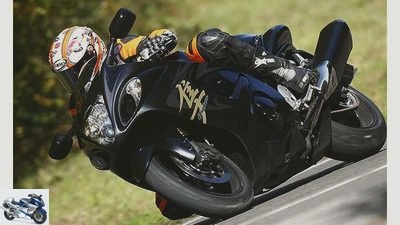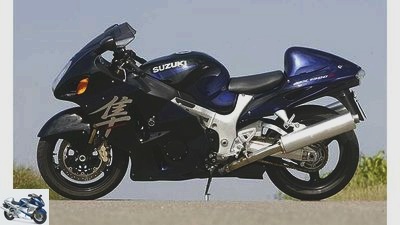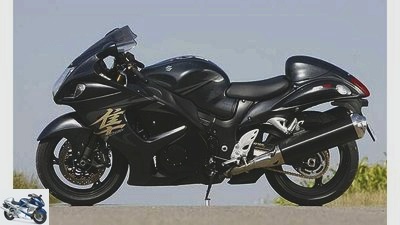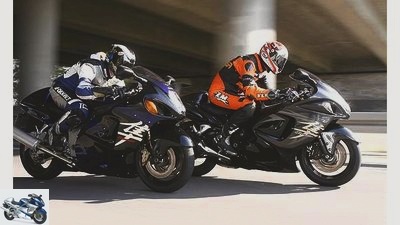Table of contents
- Comparison test: Suzuki Hayabusa old against new Shoot out boys!
- Shoot out boys!
- Speed rush
- 2004 Suzuki Hayabusa data
- 2008 Suzuki Hayabusa
- reviews
motorcycles
Comparison test: Suzuki Hayabusa old against new
Comparison test: Suzuki Hayabusa old against new
Shoot out boys!
Content of
Hayabusa, the “peregrine falcon”, has had a reputation like Hercules since 1999. Now the new bird is here. Does he even mutate into Oedipus and give his father a neat pull over the head?
Uwe Seitz
02/13/2008
Shoot out boys!
Hayabusa, that triggers something in the head: With one respect, with the other respect, with the third wish, with the next lack of understanding, and still others react fearfully. It is this call associated with the sonorous name. Pure power on two wheels is nothing for the Tupperware party. Nobody would really expect anything to change in this regard, because Suzuki has stepped up. Almost eight years after the falcon tore down sound barriers in the head amid heated discussions, the new Hayabusa is sweeping away everything that has been there so far. At least in terms of performance. Otherwise the changes to the new Haya-busa were kept within manageable limits. Therefore the question is more than justified: How much better is the new one compared to the old one?
Let’s not talk about it for a long time: In the central point a whole lot. Namely exactly 41 cm3 or 2 mm stroke per cylinder. Which, coupled with numerous other changes to the engine, results in an increase in performance of 23 hp. The Hayabusa in 2008 has a huge power plant that makes the old burner look downright tired. It’s unbelievable how it competes, even pervading downstairs. That comes very close to the famous kick in the buttocks. The amount of power that is there today in the basement of engine speed technology was obviously unthinkable just under four years ago. Sorry, old bird, but you’ve got to give up a lot of feathers here. And that has nothing to do with the condition of the used Hayabusa that a friendly car dealer (Pappas from Rutesheim) trustingly gave us for this test. The 2004 Suzuki, which had only moved almost 7500 kilometers so far, was very well maintained and in very good shape.
But as if the old power rifle weren’t plucked enough for performance alone, there are other disadvantages in the smoothness of the 1300 cc engine. While the new bird of prey accelerates very cleanly and shows hardly any load change reactions, its predecessor reveals clear weaknesses here. The very hard throttle response sometimes breaks the line, and load change knockers are annoying in the city and in heavy traffic. The new engine responded to the fact that the old engine had a rough point around 4500 rpm with unpleasant vibrations at medium speeds. ?? Yes, logo ??, top speed freaks will throw in now, ?? After all, such a Hayabusa is not for town and convoy. ?? Okay, let’s finally hit the freeway.
Speed rush

Jahn
The 2008 Hayabusa is even bigger and heavier than the older sister.
Dashed guidelines are indicated at “full bottle”. to solid lines, in both cases. One, namely the old one, takes longer, the new one considerably shorter, until the driver’s helmet crawls deep behind the window. Serious aerodynamic advantages due to a slightly wider fairing or the redesigned rear cannot be found in the new Hayabusa. However, it is more stable without sweeping along really calmly. In any case, both are uncomfortable. The footrests are too high and too far forward. Who should be able to drive kilometers on the motorway without joint pain? Given the traffic on our highways and the habits of rear-view mirror refusers, spontaneous lane-changers and left-wing radicals, Hayabusas must be able to do one thing above all: brake. Thank God the new, instead of the blunt six-piston pliers from back then, has four-piston pliers with a radial attachment, which decelerates significantly better. That’s why it’s not a great brake, it lacks the bite. And why a motorcycle aimed at top speed and motorway should not have an ABS, nor should it have one, raises questions. But before the next terrifying lane changer robs us of the last nerve, we take the exit and wag across the country road.
The basic characteristics are similar for both. The falcons calmly draw their lines, but demand a committed effort from the driver. Conveniently coordinated, the emphasis is more on brisk romping around than sporty rushing around. In any case, these birds are not handling miracles. The older bird may be a bit wobbly, but that doesn’t mean it stinks off the greenhorn, which is more neutral and looks a bit more manageable overall. However, if you brake in curves, the old Hayabu-sa positions itself much stronger. All of these disadvantages could presumably be remedied by installing the new Bridgestone BT 015 ?? M ?? minimize. The approval has been given by Bridgestone, but the tire was not yet available at the time of testing.
Conclusion: The Hayabusa fan wants performance and gets it in abundance. However, if you are sufficiently busy with the horsepower of the old falcon, you should keep it. Improvements to the brakes and driving behavior or not: Another Suzuki offers enough power and modern handling: the GSX-R 1000.
2004 Suzuki Hayabusa data

Jahn
Oldschool: Suzuki Hayabusa, model 2004.
Drive:
Four-cylinder in-line engine, four valves / cylinder, 129 kW (175 hp) at 9800 / min *, 138 Nm at 7000 / min *, 1299 cm3, bore / stroke: 81.0 / 63.0 mm, compression ratio: 11.0 : 1, ignition / injection system, 46 mm throttle valves, hydraulically operated multi-disc oil bath clutch, six-speed gearbox, G-Kat
Landing gear:
Light alloy bridge frame, steering head angle: 65.8 degrees, caster: 97 mm, wheelbase: 1485 mm, upside-down fork, Ø fork inner tube: 43 mm, adjustable in spring base, rebound and compression stage, steering damper, central spring strut with deflection, adjustable in Spring base, rebound and compression stage, spring travel front / rear: 120/140 mm
Wheels and brakes:
Light alloy cast wheels, 3.50 x 17 ?? / 6.00 x 17 ??, front tires: 120/70 ZR 17, rear: 190/50 ZR 17. First tires: Bridgestone BT 56 ?? F ??, 320 mm double disc brakes with Six-piston fixed calipers at the front, 240 mm single disc with two-piston fixed calipers at the rear
Measurements and weight:
Length / width / height: 2140/740/1155 mm, seat / handlebar height: 800/890 mm, handlebar width: 630 mm, weight with a full tank: 251 kg, v./h .: 51.0 / 49.0%, rear wheel power in last gear: 118 kW (160 PS) at 255 km / h *
Driving performance:
Acceleration: 0 100/150/200 km / h: 3.0 / 5.0 / 7.8 s, pulling power: 50 100/100 150 km / h: 5.2 / 4.7 s
Top speed: 295 km / h
Consumption:
Fuel type: super unleaded, average test consumption: 6.8 l tank capacity: 21 liters, range: 309 km
Price: (2004): 12948 Euro incl.
2008 Suzuki Hayabusa

Jahn
Suzuki Hayabusa, 2008 model.
Drive:
Four-cylinder in-line engine, four valves / cylinder, 145 kW (197 hp) at 9500 / min *, 155 Nm at 7200 / min *, 1340 cm3, bore / stroke: 81.0 / 65.0 mm, compression ratio: 12.5 : 1, ignition / injection system, 44 mm throttle valves, hydraulically operated multi-disc oil bath clutch, six-speed gearbox, G-Kat
Landing gear:
Light alloy bridge frame, steering head angle: 66.6 degrees, caster: 93 mm, wheelbase: 1485 mm, upside-down fork, Ø fork inner tube: 43 mm, adjustable in spring base, rebound and compression stage, steering damper, central spring strut with deflection, adjustable in Spring base, rebound and compression stage, spring travel front / rear: 120/140 mm
Wheels and brakes:
Light alloy cast wheels, 3.50 x 17 ?? / 6.00 x 17 ??, front tires: 120/70 ZR 17, rear: 190/50 ZR 17. First tires: Bridgestone BT 015 ?? M ??, 310 mm double disc brake with Four-piston fixed calipers, 260 mm single disc with single-piston floating caliper at the rear
Measurements and weight:
Length / width / height: 2170/840/1200 mm, seat / handlebar height: 810/880 mm, handlebar width: 690 mm, weight with a full tank: 264 kg, v./h .: 50.0 / 50.0%, rear wheel power in last gear: 135 kW (184 PS) at 271 km / h
Driving performance:
Acceleration: 0 100/150/200 km / h: 3.0 / 4.8 / 7.3 s, pulling power: 50 100/100 150 km / h: 5.0 / 4.1 s
Top speed: 295 km / h
Consumption:
Fuel type: Super unleaded, average test consumption: 7.6 l, tank capacity: 21 liters, range: 276 km
Price: around 13,500 euros plus ancillary costs
reviews

Jahn
The 2008 model exerts a lot of pressure and comes in first.
2004 Suzuki Hayabusa
drive
Goes hard on the gas, changes the load and sometimes runs quite rough. There is far less steam around the bottom, but still enough steam. The clutch suffers when driving off quickly.
landing gear
With the BT 56, the old Hayabusa stands up powerfully when braking in bends. It looks a bit more wobbly than the new one. When it is harder, it plows better.
ergonomics
Stretched far over the tank, legs wide apart, knees folded together powerfully: Comfort is different. And the wind protection at top speed should be better.
Driving fun
If you have fun driving at full steam deep behind the window, you need a Hayabusa. However, the handling is not that screaming. Modern 1000s can do a lot better.
verdict
It’s amazing how close the old one is to the new one. Overall, both are not high-flyers. The old one has a disadvantage: it lacks the eternal Busa elixir? more power.
Place 2/13 points
2008 Suzuki Hayabusa
drive
More pressure is currently not possible serially. The new Busa goes on the gas cleanly. The electronics protect against cockiness, the vibrations are annoying.
landing gear
The new one behaves more neutral in an inclined position, but the notches hit too early. If you vote softly for greater comfort, you have to expect commuting on the train.
ergonomics
Knee pain after an hour of body origami. The notches high and far in front, still touch down quickly. The wind protection is only marginally better.
Driving fun
The image of the strongest is enough for many to have fun. The pressure of the new one gives an incredible feeling. ABS would make it feel even better.
verdict
The engine brings the winning points. Suzuki made improvements without pulling up trees. If you want to win the hobby dragster race, buy a Hayabusa.
1st place / 15 points
Related articles
-
Comparison test: 600cc extreme athlete
K motorcycles Comparison test: 600cc extreme athlete Comparison test: 600cc extreme athlete Spear tips Content of They flaunt long lances at the end, are…
-
Comparison test: Japanese naked bikes
Jahn motorcycles Comparison test: Japanese naked bikes Comparison test: Japanese naked bikes Go big Content of …or go home! Big bore instead of boring,…
-
fact motorcycles Comparison test: Honda CBR 600 RR, Kawasaki ZX-6R, Suzuki GSX-R 600, Triumph Daytona 675, Yamaha YZF-R6 Comparison test: Honda CBR 600…
-
Comparison test: Supersport 600 series
motorcycles Comparison test: Supersport 600 series Comparison test: Supersport 600 series Screeching traffic Content of They scream their hearts out,…
-
Comparison test: 600s in a quintet
Jahn motorcycles Comparison test: 600s in a quintet Comparison test: 600s in a quintet Toys Content of The middle class is burning brightly! The…
-
Bilski motorcycles Comparison test: KTM 990 Super Duke, Moto Morini Corsaro 1200 Veloce, Triumph Speed Triple, Yamaha FZ1 Comparison test: KTM 990…
-
Comparison test Kawasaki Ninja ZX-6R, Triumph Daytona 675, Yamaha YZF-R6
Fact 9 pictures triumph 1/9 Triumph Daytona 675 triumph 2/9 Triumph Daytona 675 triumph 3/9 Triumph Daytona 675 triumph 4/9 Triumph Daytona 675 triumph…
-
Comparison test: Honda Hornet, Kawasaki Z 750, Suzuki GSR 600
Jahn motorcycles Comparison test: Honda Hornet, Kawasaki Z 750, Suzuki GSR 600 Comparison test: Honda Hornet, Kawasaki Z 750, Suzuki GSR 600 ABS shooters…
-
Comparison test: Suzuki B-King against BMW K 1200 R
photo: Fact motorcycles Comparison test: Suzuki B-King against BMW K 1200 R Comparison test: Suzuki B-King against BMW K 1200 R Broken laces Content of…
-
Comparison test: BMW HP2 Sport, Buell 1125R
fact motorcycles Comparison test: BMW HP2 Sport, Buell 1125R Comparison test: BMW HP2 Sport, Buell 1125R Exotic bonus Content of That was the surprise…